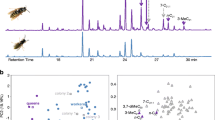Abstract
Queen pheromones mediate the reproductive division of labor in social insect colonies and provide novel opportunities for investigating the evolution of animal communication. Previous work found that queens in the ant genus Lasius produce several 3-methylalkanes in greater relative amounts than workers do. At least one of these (3-MeC31) is a queen pheromone that regulates worker sterility in two Lasius species, although there are indications that other 3-methylalkanes might also function as queen pheromones. Here, we presented workers from three Lasius species with four different 3-methylalkanes, and measured the effect on worker ovary development. In all three species, only 3-MeC31 showed clear evidence of inhibiting worker fecundity. Our results suggest that worker ants can discriminate homologous hydrocarbons that differ in chain length and only treat specific homologs as queen pheromones. These results provide insight into the conflicting selective pressures on cuticular hydrocarbons arising from their multiple roles in signaling and adaptation to the abiotic environment.


Similar content being viewed by others
References
Ablard K, Gries R, Khaskin G et al (2012) Does the stereochemistry of methylated cuticular hydrocarbons contribute to mate recognition in the egg parasitoid wasp Ooencyrtus kuvanae? J Chem Ecol 38:1306–1317
Bello JE, McElfresh JS, Millar JG (2015) Isolation and determination of absolute configurations of insect-produced methyl-branched hydrocarbons. PNAS 112:1077–1082
Blomquist GJ (2010) Biosynthesis of cuticular hydrocarbons. In: Blomquist GJ, Bagnères A-G (eds) Insect hydrocarbons: biology, biochemistry and chemical ecology. Cambridge University Press, Cambridge
Bos N, Dreier S, Jørgensen CG et al (2012) Learning and perceptual similarity among cuticular hydrocarbons in ants. J Insect Physiol 58:138–146
Butler CG, Callow RK, Johnston NC (1962) The isolation and synthesis of queen substance, 9-oxodec-trans-2-enoic acid, a honeybee pheromone. Proc R Soc B 155:417–432
Châline N, Sandoz J-C, Martin SJ et al (2005) Learning and discrimination of individual cuticular hydrocarbons by honeybees (Apis mellifera). Chem Senses 30:327–335
Fan Y, Chase J, Sevala VL, Schal C (2002) Lipophorin-facilitated hydrocarbon uptake by oocytes in the German cockroach Blattella germanica (L.). J Exp Biol 205:781–790
Fjerdingstad EJ, Gertsch PJ, Keller L (2002) Why do some social insect queens mate with several males? Testing the sex-ratio manipulation hypothesis in Lasius niger. Evolution 56:553–562
Gibbs AG (2002) Lipid melting and cuticular permeability: new insights into an old problem. J Insect Physiol 48:391–400
Gosden TP, Shastri K-L, Innocenti P, Chenoweth SF (2012) The B-matrix harbours significant and sex-specific constraints on the evolution of multi-character sexual dimorphism. Evolution 66:2106–2116
Grafen A (1990) Biological signals as handicaps. J Theor Biol 144:517–546
Holman L (2012) Costs and constraints conspire to produce honest signalling: insights from an ant queen pheromone. Evolution 2094–2105
Holman L (2014) Conditional helping and evolutionary transitions to eusociality and cooperative breeding. Behav Ecol 25:1173–1182
Holman L, Dreier S, d’Ettorre P (2010a) Selfish strategies and honest signalling: reproductive conflicts in ant queen associations. Proc R Soc B 277:2007–2015
Holman L, Jørgensen CG, Nielsen J, d’Ettorre P (2010b) Identification of an ant queen pheromone regulating worker sterility. Proc R Soc B 277:3793–3800. doi:10.1098/rspb.2010.0984
Holman L, Lanfear R, d’Ettorre P (2013a) The evolution of queen pheromones in the ant genus Lasius. J Evol Biol 17:1549–1558
Holman L, Linksvayer TA, d’Ettorre P (2013b) Genetic constraints on dishonesty and caste dimorphism in an ant. Am Nat 181:161–170
Holman L, Head ML, Lanfear R, Jennions MD (2015) Evidence of experimental bias in the life sciences: why we need blind data recording. PLoS Biol 13:e1002190
Khila A, Abouheif E (2008) Reproductive constraint is a developmental mechanism that maintains social harmony in advanced ant societies. PNAS 105:17884–17889
Kühbandner S, Bello J, Mori K et al (2013) Elucidating structure-bioactivity relationships of methyl-branched alkanes in the contact sex pheromone of the parasitic wasp Lariophagus distinguendus. Insects 4:743–760
Kwan L, Rundle HD (2010) Adaptation to desiccation fails to generate pre- and postmating isolation in replicate Drosophila melanogaster laboratory populations. Evolution 64:710–723
Martin SJ, Vitikainen E, Helantera H, Drijfhout FP (2008) Chemical basis of nest-mate discrimination in the ant Formica exsecta. Proc R Soc B 275:1271–1278
Maynard Smith J, Harper DGC (1995) Animal signals: models and terminology. J Theor Biol 177:305–311
Nakagawa S, Cuthill IC (2007) Effect size, confidence interval and statistical significance: a practical guide for biologists. Biol Rev 82:591–605
Oi CA, van Zweden JS, Oliveira RC et al (2015) The origin and evolution of social insect queen pheromones: novel hypotheses and outstanding problems. Bioessays 37:808–821
Sharma KR, Enzmann BL, Schmidt Y et al (2015) Cuticular hydrocarbon pheromones for social behavior and their coding in the ant antenna. Cell Rep 12:1261–1271
Silk PJ, Sweeney J, Wu J et al (2011) Contact sex pheromones identified for two species of longhorned beetles (Coleoptera: Cerambycidae) Tetropium fuscum and T. cinnamopterum in the subfamily Spondylidinae. Environ Entomol 40:714–726
Smith AA, Hölldobler B, Liebig J (2009) Cuticular hydrocarbons reliably identify cheaters and allow enforcement of altruism in a social insect. Curr Biol 19:78–81. doi:10.1016/j.cub.2008.11.059
Smith AA, Millar JG, Hanks LM, Suarez AV (2012) Experimental evidence that workers recognize reproductives through cuticular hydrocarbons in the ant Odontomachus brunneus. Behav Ecol Sociobiol 66:1267–1276
Van Oystaeyen A, Oliveira RC, Holman L et al (2014) Conserved class of queen pheromones stops social insect workers from reproducing. Science 343:287–290
van Wilgenburg E, Sulc R, Shea K, Tsutsui N (2010) Deciphering the chemical basis of nestmate recognition. J Chem Ecol 36:751–758
van Wilgenburg E, Symonds MRE, Elgar MA (2011) Evolution of cuticular hydrocarbon diversity in ants. J Evol Biol 24:1188–1198
Acknowledgments
We are grateful to Kirsten and Mark Holman for assisting with the experiments. LH was supported by a DECRA fellowship from the Australian Research Council (DE140101481).
Author information
Authors and Affiliations
Corresponding author
Additional information
Communicated by R. F. A. Moritz
Rights and permissions
About this article
Cite this article
Holman, L., Hanley, B. & Millar, J.G. Highly specific responses to queen pheromone in three Lasius ant species. Behav Ecol Sociobiol 70, 387–392 (2016). https://doi.org/10.1007/s00265-016-2058-6
Received:
Revised:
Accepted:
Published:
Issue Date:
DOI: https://doi.org/10.1007/s00265-016-2058-6




